Archive for the 'Fruit' Category
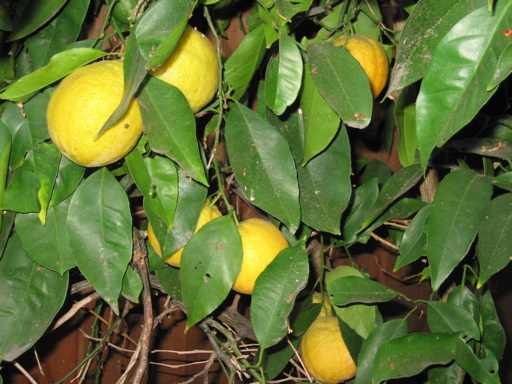
This photo is a picture of a Valencia orange tree growing in our yard. I am still harvesting oranges from this tree in late September. Valencia oranges typically ripen in mid-summer in our area. Yet, unlike many other types of fruits, Valencia oranges do not need to be picked soon after they ripen. I am amazed at how well Valencia oranges maintain their quality, even after remaining on the tree for months after ripening. Because they last on the tree so long, we can focus on eating fruit from our peach and pear trees in August, while we save the oranges for a later harvest.
Valencia oranges are tasty and juicy fruits. We often use them to make fresh orange juice. Some of them are great for fresh eating as well. Although, I have found that our Valencia oranges are generally not as consistently good for fresh eating as the oranges from our navel orange bush. The navel oranges are nearly always tasty, sweet, and tender. On the other hand, my experience has been that Valencia oranges are easier to grow than navels. Valencias don’t seem to require as much care as navels.
September 22 2008 | Oranges | Comments Off on Valencia Oranges
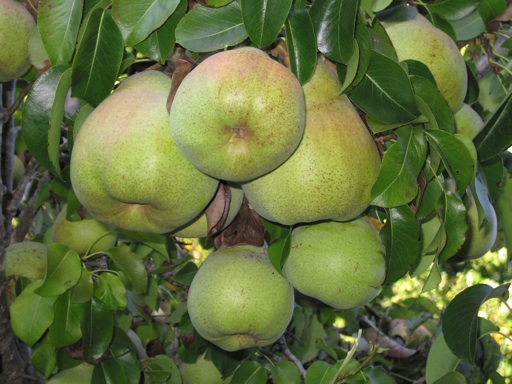
This is a picture of a Comice pear tree growing in our yard. This year, it is full of fruit. The pears are nearly ready to be picked. In our area, late September is an ideal time to harvest Comice pears.
Comice pears should be picked when they are still green and hard. When I first harvested pears from this tree a few years ago, I let the pears ripen at room temperature for several days. That turned out to be a mistake. Even after a few weeks, the pears were still very hard, and they tasted terrible.
Years after that, I read that many pears, such as Comice and Bosc, need to be stored in refrigeration for about 3-4 weeks after harvest, and then brought back to room temperature to ripen. Unlike Bartletts, Comice pears do not ripen properly at room temperature without prior refrigeration.
Last year, I picked a few Comice pears from our tree and refrigerated them for a month after harvest. Then, I took them out of the refrigerator and let them ripen in a fruit bowl for about a week. They were delicious. Properly ripened Comice pears are very sweet. They almost taste as good as Bartletts.
Back in June, I put bird netting around most of the tree. The netting keeps the local squirrels from eating the fruit. Some years, I lost the entire crop to squirrels. They typically remove the pears months before they are ready to pick. This year, I haven’t seen any half-eaten fruit lying around the base of the tree.
September 22 2008 | Pears | Comments Off on Comice Pear Tree

Our black mission fig tree is full of a second crop of figs this month. A first small crop comes in June, but the September crop is always much larger. Fig trees are one of the few fruit trees I know of that produce multiple crops in a single year. Lemons are another example.
Figs trees can get very large. Our neighbor has a big fig tree. However, our fig tree is crammed into a narrow alley between our house and a fence where it barely has enough space to grow. Yet, it still gets decent crops of figs every year. I don’t know why the former owners thought that this was a good spot to plant a tree. I wouldn’t have planted it there. But now that it’s there and somewhat mature, I am going to leave it there, rather than try to transplant it.
I keep our fig tree trimmed to about 8 feet tall and about 6 feet long. That also makes the tree easy to net and maintain. Netting the tree is a must as the fruit begins to ripen, because the squirrels in our area love to eat figs. They often take one bite out of each fig and then discard it. That’s frustrating, because it’s such as waste.
The figs I have seen for sale in grocery stores sometimes look shriveled. Our home grown figs are so tasty and fresh. I can’t imagine buying shriveled ones. I rarely have a craving to eat more than one or two figs at a time. So I have been learning what they can be used for. Apparently, figs can be used in a wide variety of recipes, including fig newtons and fig bars, which are my favorite fig treats.
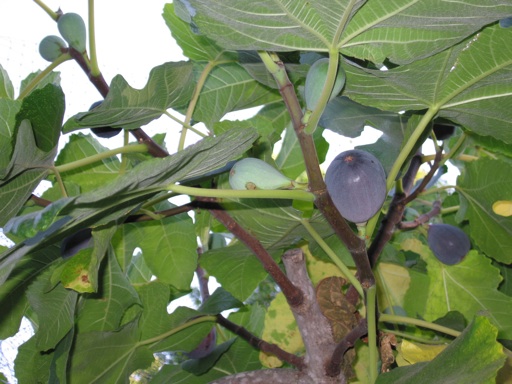
September 11 2008 | Figs | Comments Off on Black Mission Figs
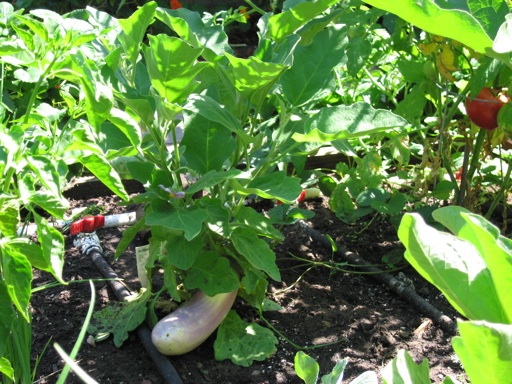
This picture is a photograph of an eggplant that is growing in one of our two raised garden beds. The eggplant variety is Lavender Touch. I selected this variety because the fruit looks so different from a typical eggplant.
I planted three eggplants as transplants in our garden on July 4. I have been watering them every few days and fertilizing them with water soluble fertilizer once a week.
I was a bit skeptical that these eggplants would produce fruit, because they were planted so late. I have never grown eggplant before this year, and I am thrilled at how easy they are to grow. They have grown substantially, especially in the last few weeks, and they are producing fruit. They seem to be thriving in the hot weather we have been experiencing. The high temperatures here have been mostly in the 90s for the past two weeks.
I have read that, in our climate, many warm weather annual fruits and vegetables can be planted from early spring through early summer, including beans, corn, and squash. I am thinking about spacing out my plantings of some annual fruits and vegetables next year. Perhaps if some transplants are set in the ground in March, some in May and some in July, I can have harvests over a longer season.
Eggplants and peppers seem to require several months of warm weather. Gardening publications typically recommend setting eggplant and pepper transplants in the ground in mid-to-late spring. However, my experience shows that eggplants planted in early summer can produce fruit, at least in our climate.
September 06 2008 | Eggplant | Comments Off on Lavendar Touch Eggplant
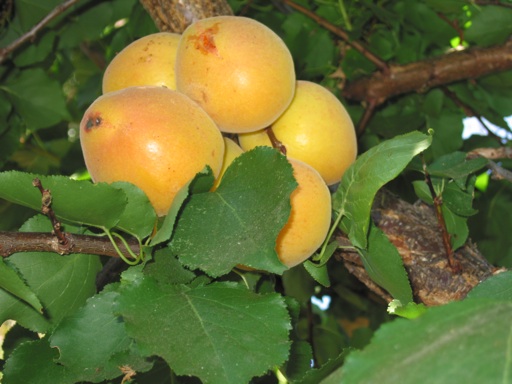
August is the high season for fruit in our backyard. In addition to peaches and Bartlett pears, I also harvested a bunch of autumn royal apricots this week. When I planted this apricot tree six years ago, I was hoping that it would live up to its name and that the apricots would ripen in the fall. This year is only the second year this tree has produced fruit, and both years the fruit has ripened in August. In retrospect, it probably would have been better to select fruit trees with different ripening schedules so that I am not overwhelmed with too much fruit from multiple trees. On the other hand, I would rather have too much fruit than too little!
Unfortunately, most of the apricots on this tree split a few weeks ago and then began to rot at the line of splitting, before they were even ripe. The cluster in this picture is one of the few on the tree that reached ripeness without splitting.
There were about 150-200 apricots on the tree 2 weeks ago, but I was only able to harvest about 3 dozen apricots that were edible. They weren’t as flavorful as Blenheim apricots. Instead of eating them fresh, my mom and I turned them into a dozen jars of apricot jam.
Recently, I have noticed that many recipes for apricot desserts call for apricot jam, instead of fresh apricots. Apparently, apricot jam can be useful for much more than spreading on toast.
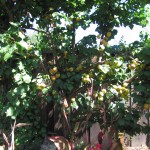
August 24 2008 | Apricots | Comments Off on Autumn Royal Apricots
« Prev - Next »






